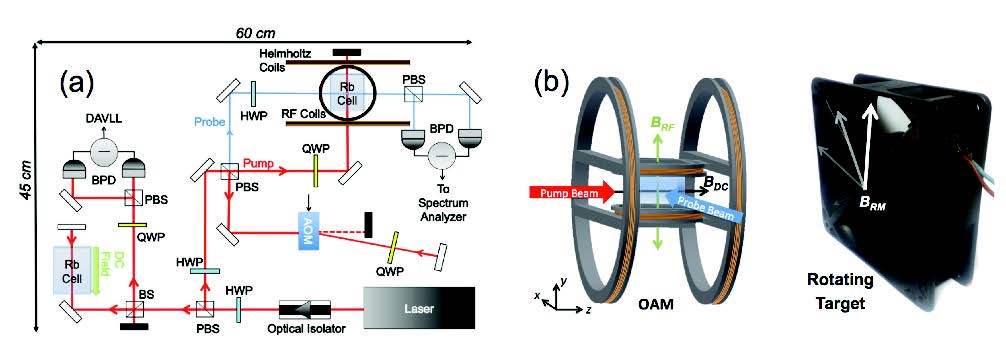The UK military system sees working equipment even behind a concrete wall

Scientists working for the UK Department of Defense have created a system that makes it possible to determine the presence of working mechanical devices even behind a concrete wall. The basic principle of such a system is the determination of changes in the magnetic field caused by working electric motors, internal combustion engines, computers and many other types of devices.
DSTL (Defense Science and Technology Laboratory) is located at the military base in Porton Down, a closed area that was created during the First World War. This base is the main scientific and technical division of the United Kingdom, where many experiments are being conducted, new technologies are being developed, and existing ones are being tested.
The task of the staff of this base is the creation of new technologies that can benefit the country. In this case we are talking about improving the country's defense. Over time, the tasks of this facility and its employees change in order to meet new threats and problems fully armed. At the beginning of 2015, DSTL employees started a project called “What's inside this building?” (What's inside that building?).
')
The goal - the development of new technologies for remote information on the situation in the room. For example, the definition of the internal structure of the structure (location of walls, furniture, electrical equipment). Additional tasks - determining the number of people inside the building, plus finding out what activities they perform (production, sorting, or any other types of activity).
The military worked on the project for two years, and finally, presented their development, which allows you to get an answer to the question "What is inside this building?". The developers have created a portable device that can detect the presence (and, accordingly, the absence) of electric motors, internal combustion engines, turbines, air conditioners, fans and many other devices and systems in the room. And all this can be determined while being outdoors. The developers claim that the system in fact determines the presence of moving parts behind the wall from the change in the magnetic field.
Any moving object made of metal periodically changes the characteristics of the magnetic field, no matter how large the metal object is. Scientists decided to use this to create their own system. As a result, they were able to develop a portable device, an atomic magnetometer, which is capable of detecting a change in the magnetic field strength.
The project manager is Luca Marmugi from the University of London. He was able to show with colleagues that the atomic magnetometer does its work almost perfectly. The device consists of rubidium atoms, which were exposed to a powerful laser beam in order to change the direction of rotation of the atoms in accordance with the characteristics of the magnetic field.
The external magnetic field changes, which leads to a change in the spins of the atoms. And this, in turn, can be determined from the photons emitted by the atom. Installation works at room temperature, protection is not required. The size of the magnetometer is comparable to the size of a small portfolio.
Marmugi and the team decided to demonstrate the capabilities of their development, having taught the system to detect the presence of rotating metal disks of various sizes. It can be as very small disks, the size of a metal coin, and all other gadgets.

The system, developed in the UK, can accurately determine the presence of mechanisms and electronic devices with rotating metal parts indoors.
The team said it was pleased with the test results: "This concept is an excellent foundation for the future." According to them, the results of the work performed allow us to speak about the possibility of creating a full-featured device that will quietly monitor people and devices inside any buildings. This is the device that intelligence agencies need. The system in question can determine the presence in an enclosed area of both metal objects with a high rotational speed (50 Hz and above), and from low - less than 50 Hz. The accuracy of the device, according to its creators, is higher than that of a number of similar systems.
The technology developed by the military, in general, is hardly unique. Up to this point, representatives of other countries have created similar methods for observing objects outside the walls of buildings.
Last year, for example, specialists from the North-West Polytechnic University developed a human surveillance system to distort the signal of a wireless network in a room. Then it was reported that a working prototype had already been created with an accuracy of 90%. This is not so much, but for a test system, just fine. The project was named FreeSense.
The system, which is the main project, determines the parameters of the human body that has appeared in the coverage area of the wireless network. In addition, the same system registers unique body movements that each person has - here we mean certain patterns (specific tilt of the head, gesture, etc.).
The system takes information for analysis from the CSI (channel state information) of the wireless network. “Due to the fact that the characteristics of each person’s body are unique, as well as the movements are unique, any person can be identified by these characteristics. You have just entered the premises, and FreeSense has already identified you, ”says one of the participants in the study.
FreeSense, however, is planned to be used as a user identification technology. Instead of a fingerprint or other systems in the enterprise, according to the project developers, you can use the usual distortion of the wireless network. On the other hand, nothing prevents you from following a person or group in the same way.
As for the project “What's inside this building?”, It is still developing. Its developers are not too public for obvious reasons, so technical details can hardly be expected in the near future.
Source: https://habr.com/ru/post/401057/
All Articles